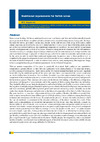Identificador persistente para citar o vincular este elemento:
https://accedacris.ulpgc.es/jspui/handle/10553/107135
| Título: | Nutritional requirements for finfish larvae | Autores/as: | Izquierdo, M. S. | Clasificación UNESCO: | 310502 Piscicultura | Palabras clave: | Arachidonic acid Broodstock nutrition Docosahexaenoic acid Eicosapentaenoic acid Fish nutrition, et al. |
Fecha de publicación: | 2004 | Conferencia: | The Second Hatchery Feeds and Technology Workshop | Resumen: | From on-start feeding, fish larvae nutritional reserves are very limited and their survival dramatically depends on exogenous feed. Hence, complete and balanced nutrition is critical of rearing success during early life stage. But most fish larvae, particularly marine ones, despite on the wild fed on a wide range of live preys, under culture conditions are forced to fed on a very limited number of preys (two or three) which frequently are not part of their natural food and hence their nutritional composition is not always the most suitable for maximum growth, development and survival of the larvae. Moreover, along larval development the fish will undertake several morphological and physiological changes which in nature are simultaneous with changes in behaviour and even habitat and type of prey fed. All these changes will affect to nutrient availability and feed utilization by the larvae in order to match their nutritional requirements. In practice, most of these problems will be simplified by the proper development of inert diets which are able to cover nutritional requirements at different moments of larval development. In order to achieve those diets we need, among many other important things, to have a complete knowledge of nutrient requirements for the different fish species. Whereas protein composition of live preys is genetically determined, lipid qualitative and quantitative composition is greatly affected by their diet and significantly varies among batches of the same type of prey, as well as among different species. Early studies on the 80´s had determined that lipids are the most important factor affecting the nutritional quality of live preys and since then a vast amount of the research conducted on larval nutrition have focussed on these nutrients. Essential long chain polyunsaturated fatty acids, as key components of bio-membranes play many important roles in their functioning and are particularly indispensable for larval development. Their presence and quantity in the diet are determining to the efficiency of digestion, absorption, and transport of some nutrients, and to the capacity of dietary energy deposition and utilization. They markedly affect eye and brain development as well as larval behaviour. Finally, as sources of eicosanoids they regulate several physiological functions including some related with larval development, immune function and stress resistance, globally affecting larval growth and survival and rearing success. Recently, molecular studies have denote the presence and activation by the fatty acid composition of the diet of a delta-6 desaturase like gene, involved in long chain polyunsaturated fatty acids synthesis. Besides, the different essential fatty acids compete among them at many different points of fish physiology, dietary unbalances among them leading to detrimental consequences for the larvae. To complicate the picture a bit more, the molecular form in which they are administered is determinant of the utilization efficiency of the dietary essential fatty acids. Other lipids such as phospholipids are considered indispensable for fish larvae, since they distinctly promote the limited ability of larvae to absorb, to re-acylate and to transport triglycerides and provide additional sources of nutrients. Fat-soluble vitamins and pigments have also prove to play important roles along larval development and their inadequate dietary levels either by shortage or excess are negative for the larvae. In a similar manner to what is found in juveniles, dietary protein utilization has been found to be affected by the dietary source, particularly during early larval stages and playing a central role in the development and maturation of the larval gut. Besides, certain free amino acids also constitute a very important source of energy, act as attractants and play a significant role in gut function and development. Finally, despite their importance, only a very limited number of studies have focused other nutritional aspects of larval development such as water-soluble vitamin and mineral requirements and energy utilization by fish larvae | URI: | https://accedacris.ulpgc.es/handle/10553/107135 | Fuente: | The Second Hatchery Feeds and Technology Workshop, Septembre 30 to October 1, Sidney, p. 8-16 |
| Colección: | Actas de congresos |
Visitas
112
actualizado el 13-abr-2024
Descargas
242
actualizado el 13-abr-2024
Google ScholarTM
Verifica
Comparte
Exporta metadatos
Los elementos en ULPGC accedaCRIS están protegidos por derechos de autor con todos los derechos reservados, a menos que se indique lo contrario.
